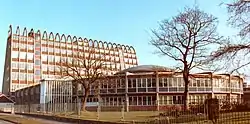Toast rack
A toast rack or toastrack is a serving piece having vertical partitions (usually from five to eight in number) connected to a flat base, used for holding slices of toast. It often has a central ring handle for carrying and passing round the table.

The term toast rack is also used in other fields, notably railways and architectural design, usually as a derivative term for objects resembling a toast rack (see below).
History
The earliest known examples of toast racks date from the 1770s. They have been made in large quantities since then and are still being made today.[1]
Design
By maintaining air gaps between the slices, the toast rack allows water vapor to escape from hot toast instead of condensing into adjacent slices and making them soggy. However, this increased air flow can also mean that the toast becomes cold more quickly.
The toast rack's design and shape follows prevailing fashion. The dividers were often made from silver wires and these in turn were soldered to either a wire-work or solid base that sat on four feet. Sometimes the base is separate and was used to dispose of any crumbs that fell. Some ingenious designs were made including expanding or folding types (so as to take up less space). Others had incorporated egg-cups or receptacles for jam or marmalade.
A designer renowned for his innovative take on the toast rack was Christopher Dresser (1834–1904), who studied at the Glasgow Government School of Design from the age of 13 and is widely thought of as the 'father of modern design'.
Modern designs are often made from stamped and folded stainless steel sheet or from welded stainless wire.
Derivative names
Architecture

Manchester Metropolitan University's Fallowfield Campus main building, the Hollings Building designed by architect L. C. Howitt, is often referred to as "The Toast Rack", due to its unusual architectural design.[2] The appearance is compounded by the fact that the building was constructed to house a department of domestic science. A neighbouring building, by the same architect, is said to resemble a fried egg. The building was Grade II listed in 1998 and was described by the prolific architectural critic, Nikolaus Pevsner as "a perfect piece of pop architecture".
An affluent block of streets in Wandsworth, South West London (SW18), is commonly referred to as "The Toast Rack" by local estate agents and residents, owing to its appearance on street plans which seems to resemble the shape of a toast rack.[3][4]
Railway and tramway carriages
.jpg.webp)
The 'toast rack passenger carriage' has been a design feature of railways since their inception, with the name particularly common on miniature and light railways, where it refers to open-sided carriages (with or, especially on miniature railways, without roofs) where the essential design is a flat frame with a series of upright seats set at right-angles to the direction of the track, thus forming a crude representation of a toast rack.[5] When the term 'toast rack carriage' is used of larger railways (up to, and sometimes including, standard gauge) it refers to coaches whose seats are set at right-angles to the track direction, and with no side corridor, central aisle, or corridor connection; thus each compartment is fully separated from the next by upright seats, again resembling the toast rack design. At these larger gauges the coaches may be fully enclosed, or 'semi-open' (with roofs and sides, but unglazed windows).[6] Many railways have examples of toast rack carriages, and some (for example the Vale of Rheidol Railway in Wales) are known for a distinct preference for the design in their rolling stock fleet.
On tramways of the horse and early electric age, toastrack cars – usually with roofs and often reversible seats – were common in warm climates or for summer use. On electric tramways, such cars were usually trailers, but motor toastracks did occur.
References
- Bradbury, Frederick (1912). History of old Sheffield plate: being an account of the origin, growth, and decay of the industry, and of the antique silver and white britannia metal trade, with chronological lists of makers' marks and numerous illustrations of specimens. Macmillan and Co., limited., page 368-370
- The design is discussed and illustrated at this web site.
- http://maps.google.co.uk/maps?f=q&hl=en&q=toast+rack,+wandsworth
- One (of many) examples of local estate agents guides to the toast rack may be read here.
- This example by Triang is from a commercial garden railway equipment set.
- A vintage (and now restored) example is illustrated here Archived 2009-07-04 at Archive.today by the Welsh Highland Railway.